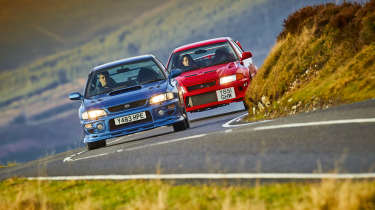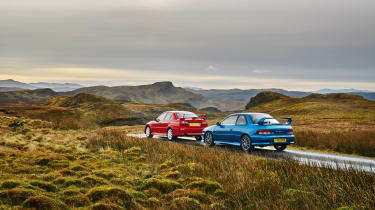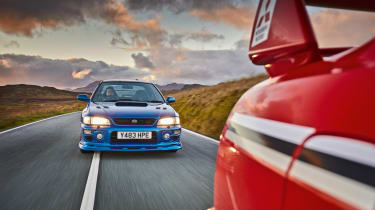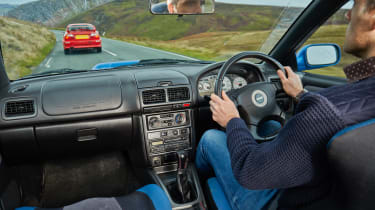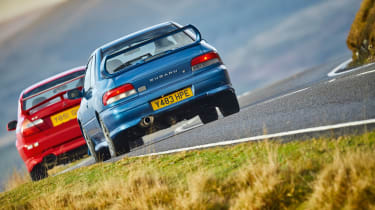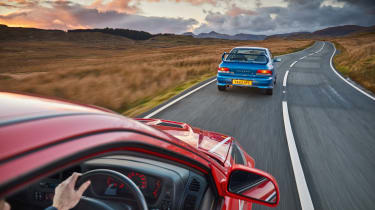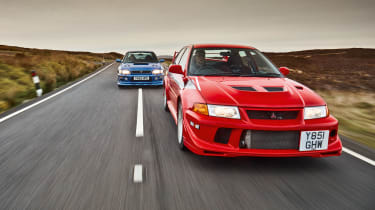Subaru Impreza P1 vs Mitsubishi Evo VI Tommi Mäkinen Edition
In the late ’90s Mitsubishi and Subaru battled it out for WRC glory. On the road the competition was no less fierce, as we discover by reuniting the Evo VI Tommi Mäkinen Edition and Impreza P1
'Torr-meh.’ ‘Torr.’ ‘Meh.’ ‘Torr-meh!’ Here comes the red car. I’m not known for my vocal impressions and my Colin McRae ‘turn’ encompasses just that one word, the Christian name of his most formidable rival. Any more and this ‘Lanarkshire’ accent traverses three entire continents in five words, and even an Evo can’t cover ground at that rate.
From my roadside vantage point in the motionless P1 I can see most of this Welsh valley stretching out before me, and what was a little red dot moments earlier is rapidly gaining in size. Suddenly it’s cresting the nearest rise on this cruelly demanding road, the surface constantly pitching up and down in amplitude like a rug that’s been tripped over in front of the fireplace.
The gentle tingle of the P1 idling reminds me of its presence. ‘Don’t go having your head turned,’ warns the constant tremble of that loping flat-four note, as the Mäkinen Edition looms ever larger. I think these two will be scrapping, arguing, furiously straining to outdo each other until the last agonising droplet of distilled crude oil disappears from planet earth.
> Subaru WRX STI S209 2020 review – US-only special driven on UK roads
We’re in north Wales. You won’t usually find evo in the area these days, but given the historic chains that bind this magazine with rally specials and this location it felt like the only place to come. Around the turn of the millennium evo’s pages featured a seemingly endless procession of constantly evolving Imprezas and Lancers, threatening supercars for outright performance and credibility amongst the youth of Generation X. For some, it was annoying; personally, I couldn’t get enough of it. It helped, of course, if you had a love of the World Rally Championship – it gave depth and clarity to why the cars were like they were, and what the model year improvements were really about.
What I hadn’t really appreciated, perhaps not until the long drive home at the end of this story, was that this would also be a story of ghosts. Of an ethos of performance car that simply doesn’t exist anymore, even in a modernised form; of a time before average-speed cameras, dashcams and wide-reaching government-backed initiatives. Every time I turn around I expect to see a 20-years-younger Dickie Meaden or John Barker giggling away infectiously about something unprintable, or photographer Gus Gregory keeping a polaroid warm in his armpit and ripping open another packet of Fuji film. Remember film in actual cameras?
Remember cassettes, too? A journey that would barely be noticeable in our Fast Fleet Audi RS4 becomes much more of a mission in a P1, if not quite Biggles with goggles. Entertainment, quaintly, is of the FM stereo and radio/cassette variety, but I’ve left my best home-brewed Britpop compilation TDK D90 at home (technically true, although which dusty box in the loft it currently resides in I have no idea). In one sense, the general lack of refinement from a base car that can probably trace the bulk of its development back to the late 1980s makes it hard work. It’s that palpable sense of each and every mile passing that does it. But it also works from the opposing perspective, in that there’s something vaguely hypnotic about being so connected to a machine doing its work, and rarely more so when that includes the metronomic throb of the Subaru’s engine.
I suspect you neither need or particularly want a history lesson, so I won’t go too heavy on it, save to say the dust-up between these two had its roots in the early 1990s. In the blue corner is the Subaru, effectively the mechanicals of the Legacy RS squeezed into the smaller, shorter Impreza shell. What began as a relatively humble performance car soon evolved into something much more serious once Subaru Tecnica International (Subaru’s internal performance division) got hold of it, and while the UK market never received those STi Version 1 to 6 models, the P1 of 2000 was finally our official exposure to full-strength wasabi-level Impreza. This was the era of the grey import, if you recall, and Subaru UK was fed up with losing business over and above the droves of Turbo 2000 Imprezas it was selling. Nevertheless, bringing in a WRX STi Version 6 Type R officially (the R denoting the two-door ‘coupe’ shell, hitherto not seen in the UK) was not as simple as adding a rear fog light, and hence a deal was struck between Subaru and Prodrive, with work commencing in late 1998.
The ‘Prodrive One’ arrived around a year later, with the bulk of the work having centred on meeting noise, emissions and safety legislation. Much of that was achieved via ECU and exhaust work, but Prodrive viewed the project holistically and wanted to radically alter the Type R’s dynamics. Having experimented with 22 different combinations of springs, dampers and anti-roll bars, it reversed the Japanese spec of stiff front and soft rear, softening the front end for more traction and stability. The firmer dampers were STi items, with Prodrive/Eibach springs that dropped the ride height by 20mm. The originally envisaged quick-rack steering never materialised, and there was no adjustable centre diff and intercooler spray like the JDM cars, nor their rear-window tints. It was a slightly more grown-up package for our tastes, then, with exceptionally heavy emphasis on the word ‘slightly’: performance was every bit as raw, the 276bhp equating to 0-62mph in 4.7sec and a top speed of 150mph, all for a not inconsiderable – in 2000 – price of £31,500. No other Impreza looked like a P1, either, thanks to designer Peter Stevens, Prodrive’s go-to man with the crayons who had already brought us the 22B. A deep new front air dam, plus side skirts and a high-rise rear wing meant to some people the P1 was about as obnoxious as it gets.
Today, living the P1 life is a mix of contrasts. If you’ve ever driven an Impreza of just about any type you’ll instantly recognise its fundamentals. You sit high in what feels like a small, narrow, old car, with drastically basic instrumentation and switchgear, and plastics so hard and shiny they almost make me feel queasy. Like the other car here, the P1 has a Comfort drive mode – a feature before its time – inasmuch as off-boost it is soft, lethargic and round-edged in its delivery. That’s not to say turbo lag is a real issue, just that without 3000rpm on the dial there’s not a good deal happening, and you can pad around accordingly. Hold on to that oversized Momo, though, and wait for it: with whine, whoosh, roar and sizzle the P1 picks up, feels energised, and maybe even wriggles just perceptibly as the total traction mandate at each four corners of the car is suddenly put under stress.
And then it revs, and revs, and revs some more, and sounds absolutely brilliant, and I’m convinced, not for the first time today, that the EJ20 engine is without doubt one of the great internal combustion engines. Up there with a Porsche ‘Mezger’ M97/76 flat-six, Lamborghini ‘Bizzarrini’ V12 or Honda K20A four banger – treasures of what will soon be yesterday’s technology of suck, squeeze, bang and blow. That laid-back, almost baggy throb tightens and quickens until it morphs into a blast and finally a scream past 6000rpm and ever upwards. But it’s not just the noise, it’s the smoothness, too – the willingness to rev and the reach of the thing.
Damn, it’s still fast. Hanging on to those gears, sensing the expanse of scenery flicking past the slender A-pillars, using the bonnet’s hump as a deflected gunsight for upcoming curves, registering the quiver of that brazen wing as it catches your attention in the rear-view mirror, all of this and more is part of the P1’s sensory overload. I love the gearshift too, the slender lever of the five-speeder offering the delicacy it suggests despite the turbo-fed torque, while the pedals and engine response are just so perfect for heel-and-toe work. Attributes such as these are becoming harder to find in a modern high-performance car.
Part of the P1’s speed is down to its body control. Prodrive’s work at tuning it in to roads such as these is immediately apparent in the way it scythes through crests, dips and awkward cambers. Like many an old performance car, what was deemed stiff riding in period is actually rather malleable and forgiving by modern, total-control standards, giving you much more information about the loads and demands placed upon the chassis. Begin a turn into a corner and there’s just the smallest delay before the nose begins to move, and from there it continues to need appreciable steering angle; it’s not a car you can just drive with a flick here and there of the wrists. If you’ve turned in too hot you’ll feel an initial suggestion of understeer, but that’s soon replaced by the P1 chewing away at the tarmac – a raw, immediate sensation of tyres at work completely absent from today’s typical on-demand all-wheel-drive set-ups.
I pull into the side of the road and collect my thoughts, and it’s while pondering with notebook and pen that I look up by chance and spot the Evo approaching. I have to be honest, I don’t waste any time turfing its driver out from behind the wheel and installing myself into its cockpit, ungracious as that may sound. I’ve been looking forward to getting reacquainted with this car for months…
It didn’t matter whether you were Subaru Japan, Subaru UK, Prodrive, or Colin McRae on a special stage start line, in the late ’90s there was one particularly sharp thorn in your side, it was usually in a combination of red and white, and somewhere on it was written the legend ‘T. Mäkinen’. If the P1 looks like a real hooligan then the ultimate second-gen Lancer simply looks as though it is on its way to a time control in Hafren Forest.
The Mitsubishi Lancer Evolution VI Tommi Mäkinen Edition (to give it its full name, or TME for short) is, in reality, an Evo ‘6.5’. The 6 itself was effectively just a small development of the Evo 5, a car that had answered the major drawback of the ‘narrow’ original 4 of the second-generation Lancer by dramatically swelling the wheelarches and the track underneath. That wasn’t about making the car look good on a marketer’s PowerPoint presentation, although it also had that effect; it was simply about improving the lateral grip on offer to Mäkinen and teammate Richard Burns on tarmac stages in 1998. In fact, a glance at the brochure for Evos in this era is a brisk shuttle ride into an alternative solar system, where carefully photoshopped images and talk of premium materials and driver assistance systems are replaced by shots of optional tarmac-spec dampers and rally mud flaps. It’s so free of pretence, it’s wonderful.
The 6 had brought a smaller, if still extravagant aero kit over the 5, in line with rally regulations that were undergoing a fundamental shift from the old homologation-based Group A formulae to the World Rally era. The TME celebrated Mäkinen and co-driver Risto Mannisenmäki’s 1999 World Championship win and went on sale in Japan at the beginning of the following year. It had revised aerodynamics, the titanium-blade turbocharger usually seen on the made-for-motorsport RS versions, factory ‘tarmac’ suspension settings (10mm lower than standard), a quicker steering rack, white 17-inch Enkei alloys, a bigger-bore exhaust and, for £700, a sticker pack that when combined with Passion Red for the exterior really did make it look like Mäkinen’s company wheels. It didn’t reach the UK officially until 2001, whereupon it retailed for £32,995.
Much like the Impreza, I could be blindfolded but I’d always know what car I was sitting in, thanks to the uniquely zingy, bassy idle of the Evo’s 4G63 engine, and the curiously sweet smell of 1990s Mitsubishi plastics. I find its seats more supportive and the driving position much better, although Will Beaumont in the other car finds the inverse to be true, so presumably it depends on your own build. The TME is based on a newer overall design, and feels it inside: the dash and plastics are more modern, if still extremely basic.
Both these cars are so obviously four-wheel driven that to operate them clumsily feels as though you’re immediately shortening the life of clutches and drive components. Be lazy or imprecise and it’s as though you’re physically hurting the car. The Evo takes this a stage further because it’s so madly precise, so free of any slack, anywhere, that really only a Caterham makes a valid modern comparison. The throttle response can be measured per millimetre of pedal travel; mismatch, even slightly, just any one of the throttle, clutch or gearchange and the Evo will have your head snapping forward into invisible bricks and mortar. It is totally, utterly, beguilingly free of any sense of compromise at all. Mind wandering, I imagine Mannisenmäki is in the left-hand bucket (why wasn’t the opposing seat stitched with ‘R. Mannisenmäki’?) tutting and puffing at even the slightest sign of ineptitude from the driver. Then again, he was used to the then rather more monosyllabic, shy Mäkinen grinding the opposition into submission with his relentless raw speed.
The five-speed gearbox is so precise, too, so fundamentally mechanical in the feel of cogs meshing. The Evo demands to be driven properly at all times, but that perversely is one of its great joys. It too has a notable off-boost zone, where it can be driven around at a leisurely but satisfying pace, made all the more enjoyable as the driver attempts to finesse out every last input – and all the more surprising to locals who expect the Evo to be travelling around these roads at warp speed.
Don’t get me wrong though: the other thing the TME does astonishingly well is cover the ground absurdly quickly. Its engine couldn’t be more different to the P1’s, in that it’s all about the sudden explosion of torque in the low- and mid-range – in its own way equally captivating, and arguably more effective. Primed and pulling hard, the TME is a frenzied ball of thrashy, coarse energy, belying the official power figure of ‘just’ 276bhp. We all know you can tune an Evo to immense power levels, but not once do I feel short-changed today with the standard output. Neither could the TME’s dynamics be more different. Take a look at the photos and it’s hard to believe how high it sits, how much fresh air passes beneath its blocky chin. It’s like a bug almost, hopping down the road in giant leaps. But there’s a clue in that stance, for the TME is true to its brief of the tarmac stage, without thought to smooth racetracks or designer-led visuals.
Essentially, there is nothing – and I really mean nothing – that can catch a TME out. There’s not a hump, a sudden depression, even a crater for heaven’s sake, that deflects it off line, troubles the bump stops or makes the driver wince; it’s almost as if it’s floating UFO-like above the road’s surface. But if that makes it sound a remote experience then nothing could be further from the truth, for the same precision of the drivetrain is carried through into everything else the car does, including the steering, which has the purity and immediacy of an unwavering laser beam: with the quick rack every half a degree makes a big difference.
I just can’t jump into the Evo and drive it cohesively at first. It takes time to understand the demands it places on the driver; time to comprehend just what the car’s agility, almost in-built nervousness, allows you to do. Twenty years later there’s still not a driving experience quite like this. It feels so odd that something so exacting, unfiltered, and demanding, should be found within the confines of a very average Japanese saloon car body.
Undoubtedly, in terms of pace these cars are well matched, even if they achieve the same results from such opposing perspectives. Back in the Impreza and you really notice the absence of the Evo’s instant responses, its hyperactive tail; the P1 feels much more traditional, and traditionally four-wheel drive. Yet I like that. You can work with it, and it’s always utterly transparent, the feedback from the steering really coming into play once more than five degrees of lock is on, no rubberiness or squish in the way it changes direction.
The days are short this time of year and the Subaru’s headlights are average at best, but as the gloom descends I’m still revelling in the sound, soul and fury of the P1. A drive in the Lancer and I wonder if there could be anything more sensational on four wheels, but then exposure to the Subaru’s flat-four for a few moments has my affections heading rapidly once again in that direction. I love the P1 for its truly unique and bombastic engine, its wonderful sensation of being so furiously four-wheel drive – of digging into a road’s surface with such devotion that if it were a person the blood would be dripping down from destroyed fingernails.
So no, I’m not going to choose a winner. Trying to call a verdict is like trying to solve a reciprocal, mythical equation of the sort that would have kept any toga-wearing scholar in ancient Greece befuddled for decades. Yet, spearing along the M54, returning the P1 to its most generous owner, one thought preoccupies my mind. As it approaches its 20th birthday, how is it that the TME offers a level of driver interaction and outright ability that matches and, in plenty of ways, exceeds what is offered by the new performance cars you’ll find in The Knowledge section of this very magazine? Is that what the dark art of homologation really did for us? How we all miss those crazy cars so very, very much.
Specs
Mitsubishi Lancer Evo VI Tommi Mäkinen Edition
| Engine | In-line 4-cyl, 1997cc, turbo |
| Power | 276bhp @ 6500rpm |
| Torque | 275lb ft @ 2750rpm |
| Weight | 1365kg |
| Power-to-weight | 205bhp/ton |
| 0-62mph | 4.6sec |
| Top speed | 150mph |
| Price when new | £32,995 |
| Value today | £10,000-30,000 |
Subaru Impreza P1
| Engine | Flat-four, 1994cc, turbo |
| Power | 276bhp @ 6500rpm |
| Torque | 260lb ft @ 4000rpm |
| Weight | 1283kg |
| Power-to-weight | 219bhp/ton |
| 0-62mph | 4.7sec |
| Top speed | 150mph |
| Price when new | £31,500 |
| Value today | £12,000-42,000 |
Thanks to the Harrington Collection for lending its fabulous Impreza P1

